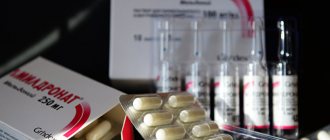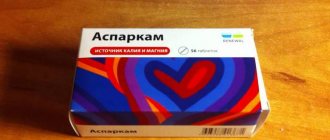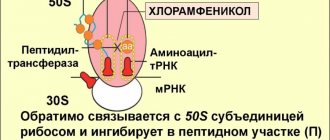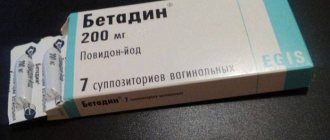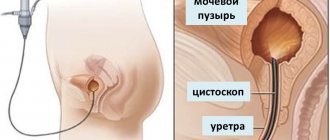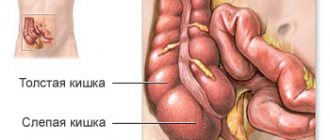- April 19, 2020
- Cardiology
- Ulyana Romanova
From this article you will learn for what purposes patients may be prescribed injections with Mildronate. This is a metabolic drug, a synthetic analogue of gamma-butyrobetaine - a substance found in every cell of the human body. What is it for? Under what conditions should it be taken? Are there any contraindications? Now you will find out the answers to many questions regarding this topic.
Application of Mildronate
Mildronate is recommended for the treatment of the following diseases in adults:
- Coronary artery disease – damage to the myocardium of the heart;
- Heart failure - impaired myocardial functionality;
- Overtraining syndrome in sports – the appearance of persistent pain;
- Increased mental stress, decreased concentration and memory;
- Hangover syndrome – the appearance of symptoms of alcohol withdrawal;
- Dysfunction of cerebral circulation;
- Decreased performance, chronic fatigue syndrome;
- Hemophthalmos - penetration of blood or blood clots into the vitreous body of the eye;
- Retinopathy is damage to the retina of the eye.
As a result of the action of Mildronate, blood circulation improves and myocardial contractility is normalized, therefore the drug is used in the complex therapy of cardiovascular diseases. In sports, Mildronate is taken by athletes to increase physical strength and improve metabolism.
Indications
The instructions for using injections with Mildronate list all the conditions for which this drug is prescribed. They can be identified in the following list:
- Chronic heart failure.
- Retinal hemorrhages of various etiologies.
- Hemophthalmos.
- Thrombosis of the central retinal vein, as well as its branches.
- Dyshormonal cardiomyopathy.
- Physical and mental stress.
- Cardiac ischemia. In this case, it is used as an addition to complex therapy to reduce the risk of myocardial infarction and angina pectoris.
- Cerebrovascular insufficiency.
- Stroke and other chronic and acute disorders of the blood supply to the brain.
- Deteriorated performance.
- Retinopathy of various etiologies (hypertensive or diabetic).
- Abstinence syndrome that occurs in chronic alcoholism.
But nevertheless, even if a person believes that he has all the indications for using droppers with Mildronate or injections, it will not be possible to start therapy. The medication is serious, and therefore prescription - self-medication with it will be fraught with consequences.
Mildronate - a little history
Mildronate is also known as Meldonium. Actually, meldonium is the active ingredient of mildronate.
Meldonium was developed in the 1970s by Ivars Kalvins - then director of the Institute of Organic Synthesis of the Academy of Sciences of the Latvian SSR - one of the leading research institutes in this field in the USSR. It was his scientists who were instructed to make a “product for household use” from meldonium, which then had a military purpose.
Initially, the development was called “mildronate”. It was registered in 1976, and began to be used in 1984. On December 7, 2011, by order of the government of the Russian Federation, meldonium was included in the list of vital and essential drugs.
As of January 1, 2021, meldonium is banned by the World Anti-Doping Agency (WADA) for pre- and non-competition use by athletes. Then, many famous Russian athletes, for example, tennis player Maria Sharapova, were disqualified for using meldonium, although they claimed that they last took it in 2015. The international doping scandal was just beginning to gain momentum...
By the way, L-carnitine, a popular dietary supplement that is freely sold in many countries and is not on the list of prohibited drugs, has properties similar to meldonium.
It’s not possible, but it’s prescribed. Why does a pregnant woman need meldonium?
In addition to absolute ones, there is also a relative contraindication to the use of the drug: Mildronate is not recommended for use during pregnancy. Why is it still prescribed to expectant mothers and how safe is it?
The effect of meldonium on the fetus has not been studied to date, so the doctor must take into account the possible negative consequences of its use. The main indication for prescribing Mildronate to a pregnant woman is phytoplacental insufficiency. With this pathology, blood circulation between the maternal body and the fetus is disrupted. This is extremely dangerous: oxygen starvation can inhibit the development and growth of the baby in the womb, cause all sorts of disorders in the child’s central nervous system and even lead to his death.
That is why, if treatment with safer medications does not give a positive result, the doctor prescribes Mildronate to the pregnant woman. It is one of the most effective drugs to eliminate such problems. There are no recommended dosages - they are selected by the doctor strictly on an individual basis.
How Mildronate works
The active substance meldonium, acting in several directions at once, establishes a balance between the cells’ need for oxygen and its delivery, removes accumulated toxins and neutralizes their negative impact on the body. Thanks to this, a person taking Mildronate becomes more resilient to mental and physical stress and gets an improved metabolism.
Other results of using Mildronate:
- normalization of cerebral circulation;
- improvement of blood circulation in the area of ischemia;
- slowing down the formation of the necrotic zone;
- elimination of functional disorders of the nervous system;
- reduction of the rehabilitation period in the treatment of heart disease, stroke and alcoholism
Mildronate is easily absorbed and excreted from the body after 3-6 hours. Although traces of it can still be found for several months.
Alcohol compatibility
Mildronate is prescribed by therapists strictly according to indications and the drug is dispensed at the pharmacy using prescription forms. Caution and control of use are due to the pronounced influence of the active component on the cardiovascular and central nervous system.
Results of studies on the compatibility of Mildronate with alcoholic beverages:
- Meldonium enhances the inhibitory effect of ethanol on centers in the brain;
- The liver enzyme system is activated, which promotes the rapid removal of the drug from the body.
The drug is used to relieve withdrawal symptoms in patients with alcohol dependence, so drinking alcohol neutralizes the effect of therapy.
Use of Mildronate in sports
Mildronate is highly valued by athletes for its ability to improve cellular metabolism, as it accelerates the removal of toxins and free radicals from the body. Thus, Mildronate has an antioxidant effect: it improves well-being, slows down the aging process of cells and helps rapid muscle recovery.
Athletes take the drug to reduce pain and recover faster after training. As a result of taking Mildronate, symptoms of overtraining are relieved and fatigue goes away. The athlete’s general condition improves, which can affect his personal performance.
The benefits of the drug are difficult to overestimate during periods of intense physical activity, when training goes on almost without a break, for example, before a competition, and the body does not have time to rest.
Mildronate is recommended to be taken for up to 6 weeks without a break, so as not to cause addiction to the drug. To obtain good results, taking Mildronate should be combined with proper nutrition and daily routine.
Drug interactions
It is allowed to combine Mildronate with the following drugs:
- Antiarrhythmic drugs.
- Bronchodilators.
- Antianginal agents.
- Antiplatelet agents.
- Anticoagulants.
- Diuretics.
It is also important to know that Mildronate enhances the effect of cardiac glycosides. And due to the fact that due to the combination of the drug with alpha-blockers, nifedipine and nitroglycerin, there is a risk of developing arterial hypotension and moderate tachycardia, you need to be careful when combining them. Mildronate enhances their effect.
Composition of Mildronate and release forms
The composition may vary depending on the form of release.
- Mildronate ampoules contain meldonium and water for injection.
One ampoule contains 5 ml of the drug, which contains 250 mg of the active substance. Available in cardboard packaging of 10 ampoules.
- Mildronate capsules:
- meldonium;
- potato starch;
- calcium stearate;
- colloidal silicon dioxide;
- titanium dioxide and gelatin in the shell.
Capsules come in two types: with 250 mg and 500 mg of active substance. Sold in cardboard packs of 40 and 60 pieces.
- Mildronate in syrup:
- meldonium;
- purified water;
- cherry essence;
- glycerol;
- dyes;
- propylene glycol.
Two packaging: 150 ml and 250 ml. 5 ml (one dose) of the medicine contains 250 mg of the active substance. Available in cardboard packaging with a 5 ml measuring spoon.
Mildronate enters the blood most quickly in ampoules, immediately after administration of the drug. The syrup also has a good absorption rate. But capsules are more convenient to take.
pharmachologic effect
- Mildronate acts as an angioprotector: dilates blood vessels, reduces tissue swelling, stimulates metabolism in cells, restores blood composition;
- Cardioprotector: strengthens the heart, accelerates cell regeneration, removes toxins;
- The drug has an antihypoxic effect: reduces tissue oxygen demand, activates cellular metabolism, stimulates regeneration, improves tissue nutrition;
- Antianginal effect: prevents and relieves attacks of angina, transports oxygen to the myocardium.
The high effectiveness of Mildronate is the result of a complex effect on the body. The particular benefits of the drug are often discussed by athletes who note an improvement in metabolic processes after its use.
Pharmacokinetics
The maximum plasma concentration of Mildronate for injection is achieved almost immediately after its parenteral administration. It is quickly distributed in tissues and binds to blood plasma proteins. The bioavailability of the drug is 100%.
Attention! The drug partially penetrates the hematoplacental barrier, and has also been found to pass into breast milk.
Metabolism of Mildronate occurs in the liver
The drug and its metabolites are excreted primarily by the kidneys. The half-life is 3-6 hours.
Instructions for taking Mildronate
You can take the drug only on the recommendation of a doctor. As a rule, in the first half of the day, as it has a tonic and stimulating effect. Dosage and rules differ depending on the release form.
Capsules
Reception depends on the purpose.
- For the treatment of cardiovascular diseases in complex therapy, take 0.5-1 grams per day for up to 6 weeks. 250 mg capsules are taken up to 4 per day, 500 mg tablets - up to 2 per day. The daily dose should be divided into 1-2 doses.
- For the treatment of chronic dysfunctions of cerebral circulation, the dosage is the same. During the year, no more than 2 courses lasting up to 6 weeks each.
- For the treatment of chronic alcoholism and detoxification, take 500 mg 4 times a day. The duration of therapy reaches 10 days.
- To increase endurance and physical strength, athletes take 1-2 capsules twice a day before training. Duration of treatment is 21 days, during competitions – up to 14 days.
To make swallowing easier, drink with water.
Syrup
- For the treatment of heart diseases and deterioration of cerebral circulation, take 1 scoop of syrup twice a day.
- The dosage for athletes is selected individually, based on the daily norm of 1 gram (4 scoops), divided into two doses.
Ampoules
The solution in ampoules is administered intravenously, intramuscularly and by injection into the eye.
- Diseases of the heart and brain: 2 ampoules into a vein per day, 1 ampoule 2 times. The course is from 4 to 6 weeks.
- Chronic alogolism: 1 gram per day for 10 days intravenously or intramuscularly.
- Athletes need to administer 500 mg intravenously once, up to 3 weeks.
- Diseases of the retina: eye injection of 0.5 ml of solution per day, up to 10 days.
Vitamin for the heart, what characteristics do doctors and patients give to the medicine?
If you study the reviews of cardiologists and patients about Mildronate, you can conclude: this is certainly an effective drug. Both doctors and the patients themselves characterize him on the positive side; the assessments differ only in the degree of emotionality. People write: “This is an excellent medicine”, “It treats with a bang!”, They call it “salvation” for heart patients and those who suffer from vascular disorders (high blood pressure, cerebral atherosclerosis)
Patients note that the drug not only treats - it improves short-term memory and attention, “makes the head clear”, eliminates noise in the head, relieves anxiety and fear, increases intellectual abilities
Why, according to reviews, is Mildronate prescribed? First of all, it is prescribed to people with heart failure, hypertension and acute cerebrovascular accidents. It helps heart patients lead a normal life.
It is extremely rare for people to write that taking the medicine had no effect on their well-being. The creator of this drug, Ivars Kalvins, commented on the accusations of its ineffectiveness in the following way: “If you take meldonium, you must move. It’s wrong to expect a positive effect from it while lying on the couch.” Don't discount fakes either.
Contraindications, side effects, overdose
Mildronate is prohibited for use:
- Under the age of 18;
- Pregnant and breastfeeding;
- With increased intracranial pressure;
- With a brain tumor;
- If you are sensitive to substances contained in the drug.
The drug is strictly contraindicated in liver failure. In chronic forms of diseases, it can be taken for a short period and after the course, an examination can be carried out in case of complications.
Acute renal failure is noted as a contraindication. In case of chronic kidney disease, the drug should be taken for a long time with caution, monitoring the condition of this organ. Clinical studies of the drug's effects on the kidneys have not been conducted.
It is also not recommended to combine Mildronate with drinking alcohol. You can drink alcohol 12 hours after taking the drug so that the active substance is removed from the body.
Side effects are observed either due to individual intolerance to the components of the drug, or when taken incorrectly. Among them:
- skin rashes;
- malaise;
- decrease or increase in blood pressure values;
- excitability;
- diarrhea.
If any disturbances are observed, you should consult a doctor and possibly change your therapy.
Keep in mind that tachycardia is possible when taking Mildronate simultaneously with nitroglycerin and nifedipine or antihypertensive drugs. In general, Mildronate combines well with other medications, especially with drugs against pulmonary diseases and arrhythmia.
There is also no data on the adverse effects of the drug in case of overdose. But it is better to rinse your stomach and consult a doctor.
Mildronate is well tolerated by the body without causing toxicity. Rarely, increased blood pressure, tachycardia, nausea, and weakness are possible.
Store the drug at a temperature not exceeding 25 degrees Celsius and out of the reach of children.
Reviews
Finally, it’s worth discussing them too. Doctors say that Mildronate is an excellent antianginal drug, widely used in cardiological practice. In general, it prevents oxygen starvation and strengthens the vascular wall well, harmonizing and enhancing microcirculation. This makes it a high-quality metabolic substance that comprehensively improves the functioning of the body.
The people themselves who have taken this drug speak highly of it. They say that if you need a good brain stimulant, then you should choose Mildronate. Some students start taking it a couple of weeks before exams. Immediately before an important event, there is no point in using the drug - the effect is cumulative. You can improve the result by combining the drug with multivitamins and iodine.
This remedy also helps people who are not feeling very well physically and mentally. This condition often turns out to be chronic fatigue syndrome.
With such an illness, almost every day seems like a real test, when you even wake up with a feeling of powerlessness. And if a person understands that his energy reserves are really running low, then it’s time to take Mildronate. Surprisingly, in this condition, a course of 10 injections is sufficient. After its completion, the effect will persist for about another half month, and after a few weeks it will dry up. Therefore, treatment with injections is, of course, good, but we must deal with the main problem, the cause of the disease.
In general, Mildronate is a real “3 in 1”. The product is a beneficial remedy for the heart, a dope for the body and a cure for many diseases. However, only a specialist should prescribe its use!
Mildronate. Analogs, prices
There are many analogues of Mildronate on the market; if a replacement is necessary, your doctor will help you make a choice.
- Vasomag - from 200 rubles;
- Cardionate – from 170 rubles;
- Meldonium - from 230 rubles.
- Melfort - from 500 rubles;
- Midolat - from 128 rubles;
- Metonate – from 300 rubles;
- Riboxin - from 37 rubles.
The cost of the drug depends on its release form and region. For example, prices in Moscow:
- ampoules – from 417 rubles;
- syrup - from 300 rubles.
- Capsules - from 300-550 rubles.
